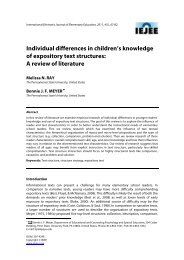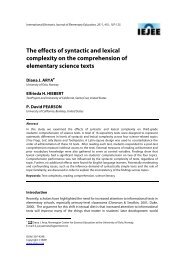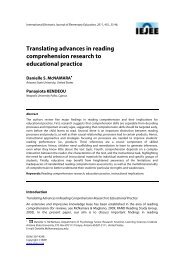Preparing for reading comprehension: Fostering text comprehension ...
Preparing for reading comprehension: Fostering text comprehension ...
Preparing for reading comprehension: Fostering text comprehension ...
- No tags were found...
Create successful ePaper yourself
Turn your PDF publications into a flip-book with our unique Google optimized e-Paper software.
International Electronic Journal of Elementary EducationReferencesAlp, I.E. (1994). Measuring the size of working memory in very young children: The Imitation Sortingtask. International Journal of behavioural Development, 17, 125-141.Applebee, A. (1978). Teaching high-achievement students: A survey of the winners of the 1977 NCTEAchievement Awards in writing. Research in the Teaching of English, 1,Bishop, D. V. M., & Adams, C. (1990). A prospective study of the relationship betweenspecific language impairment, phonological disorders and <strong>reading</strong> retardation. Journal ofChild Psychology and Psychiatry and Allied Disciplines, 31, 1027-1050.Boeke, J. (2008). Dikkie Dik; small creatures, Dutchbook BV, Haarlem.Bruna, D. (2008). Nijntje in de dierent (Nijntje in the zoo). Mercis Publishing BV, Amsterdam.Cain, K. & Oakhill, J. (2007). Reading <strong>comprehension</strong> difficulties.: Correlates, causes, and consequences.In K. Cain & J. Oakhill (Eds.), Children’s <strong>comprehension</strong> problems: Oral and written language (pp.41-75). New York: Guild<strong>for</strong>d.Cain, K., Oakhill, J. V., & Bryant, P. E. (2004). Children’s <strong>reading</strong> <strong>comprehension</strong> ability: Concurrentprediction by working memory, verbal ability, and component skills. Journal of EducationalPsychology, 96, 31–42.Catts, H. W., Fey, M. E., Zhang, X., & Tomblin, J. B. (1999). Language basis of <strong>reading</strong> and <strong>reading</strong>disabilities: Evidence from a longitudinal investigation. Scientific Studies of Reading, 3, 331–361.Coulombe, S., Tremblay, J-F, Marchand, S (2004). Literacy scores, human capital and growth acrossfourteen OECD countries. Ottawa: Statistics Canada.Delft, G. (2000). Haas en Konijn; een bos vol vrienden (Hare and Rabbit; a <strong>for</strong>est full of friends). Uitg.Holland, Haarlem.Faggella-Luby, M. N., & Deshler, D. D. (2008). Reading <strong>comprehension</strong> in adolescents with LD: What weknow; what we need to learn. Learning Disabilities Research & Practice, 23, 70-78.Gernsbacher, M.A. (1990). Language <strong>comprehension</strong> as structure building, Hillsdale, N.J.: Erlbaum.Gersten, R., Fuchs, L. S., Williams, J. P., & Baker, S. (2001). Teaching <strong>reading</strong> <strong>comprehension</strong> strategies tostudents with learning disabilities: A review of research. Review of Educational Research, 71(2),279-320.Goldman, S. R. (2004). Cognitive aspects of constructing meaning through and across multiple <strong>text</strong>s. InN. Shuart-Faris & D. Bloome (Eds.), Uses of inter<strong>text</strong>uality in classroom and educational research(pp. 317–351). Greenwich, CT: In<strong>for</strong>mation Age.Goldman, S.R., & Varnhagen, C.K. (1986). Memory <strong>for</strong> embedded and sequential story structures.Journal of Memory and Language, 25, 401-418.Graesser, A. C., Singer, M., & Trabasso, T. (1994). Constructing inferences during narrative <strong>text</strong><strong>comprehension</strong>. Psychological Review, 101, 371-395.Hansen, J., & Pearson, P. D. (1983). An instructional study: Improving the inferential <strong>comprehension</strong> ofgood and poor fourth-grade readers. Journal of Educational Psychology, 75, 821-829.Kaakinen, J. K., Hyöna, J., & Keenan, J. M. (2003). How prior knowledge, WMC, and relevance ofin<strong>for</strong>mation affect eye fixations in expository <strong>text</strong>. Journal of Experimental Psychology:Learning, Memory, and Cognition, 29, 447-457.Kendeou, P., Lynch, J.S., van den Broek, P., Espin, C., White, M., & Kremer, K.E. (2005). Developingsuccessful readers: Building early narrative <strong>comprehension</strong> skills through television viewingand listening. Early Childhood Education Journal, Online First. Retrieved fromhttp://dx.doi.org/10.1007/s10643-005-0030-6Kendeou, P., van den Broek, P., White, M.J., & Lynch, J. (2009). Predicting <strong>reading</strong> <strong>comprehension</strong> inearly elementary school: The independent contributions of oral language and code-relatedskills. Journal of Educational Psychology, 4, 765–778.Kendeou, P., van den Broek, P., White, M., & Lynch, J. (2007). Comprehension in preschool and earlyelementary children: Skill development and strategy interventions. In D.S. McNamara (Ed.)Reading <strong>comprehension</strong> strategies: Theories, interventions, and technologies, (pp.27-45).Mahwah, NJ: Erlbaum.Kintsch, W., & van Dijk, T.A. (1978). Toward a model of <strong>text</strong> <strong>comprehension</strong> and production.Psychological Review, 85, 363-394.266





